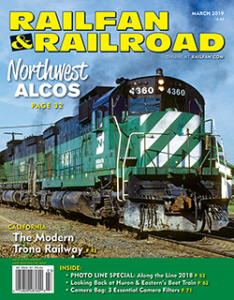 Railways often seem to be an anachronism, an industry defined by its resistance to innovation. Especially to outsiders, it feels like a thing of the past, defined by bulky equipment, rusty metal, and slow speeds. Some of these decisions, however, are the result of a pragmatic streak. For many railroads, the old saw applies — if it isn’t broke, don’t fix it. Despite experimentation with different materials, most lines rely on wooden ties much as they did 150 years ago. Plenty of grade crossing signals, meanwhile, still rely on old analog relays rather than digital technologies. Another example — many short line and regional railroads rely on locomotive fleets that average 30, even 40 years old. All of these decisions relate to the simple fact that these technologies still work.
Railways often seem to be an anachronism, an industry defined by its resistance to innovation. Especially to outsiders, it feels like a thing of the past, defined by bulky equipment, rusty metal, and slow speeds. Some of these decisions, however, are the result of a pragmatic streak. For many railroads, the old saw applies — if it isn’t broke, don’t fix it. Despite experimentation with different materials, most lines rely on wooden ties much as they did 150 years ago. Plenty of grade crossing signals, meanwhile, still rely on old analog relays rather than digital technologies. Another example — many short line and regional railroads rely on locomotive fleets that average 30, even 40 years old. All of these decisions relate to the simple fact that these technologies still work.
It can almost be said that on the other side of this attitude is a deep-seated skepticism about innovation. The new is often met with reluctance, and change treated with suspicion. Yet there are pragmatic reasons even for this negativity. Railways work at their best — which is to say, their most profitable — when they move the most amount of goods at the least cost. While new methods may bring greater efficiencies, the cost of investing in such methods can sometimes make it more economical to stick with the old ways. It is not particularly surprising, then, that when a railroad introduces a new practice, it is met with derision by others within the industry.
Consider Precision Scheduled Railroading (PSR), wherein a railroad operates trains on a fixed schedule rather than in response to fluctuating demands. The management of locomotives, equipment, and even crews is thus normalized into a predictable routine. More tonnage can be handled with fewer assets and fewer employees. Moreover, the movement of freight itself is stabilized, so shippers can know precisely when and where goods will flow. PSR is generally associated with E. Hunter Harrison, who from 1993 until his death in 2017, led the Illinois Central, Canadian National, Canadian Pacific, and finally, CSX. At each company, Harrison implemented PSR. Last September, officials at Union Pacific announced they, too, would implement PSR.
The rollout of PSR through most of the North American Class Is has been met with frequent criticism by railway employees, business analysts, and even railfans, mostly as a result of the dramatic “one fell swoop” rollout that was typical of Harrison’s implementations. Established operating practices were swept away in a matter of months, weeks, or even days, a real shock to a tradition-bound industrial culture. UP, meanwhile, has taken the opposite extreme, phasing in the new practice system-wide over the course of two years. This, too, has come under criticism, with former colleagues of Harrison arguing that a phased approach weakened the efficiency gains of PSR.
All of this hoopla, including Harrison’s credit for fathering PSR, is overblown. The idea of operating trains to a fixed schedule is not innovative at all, but rather a return to a time-honored tradition that, before the advent of Centralized Traffic Control dispatching systems, was a defining characteristic of North American railways. This was especially true of the UP, right up until its 1982 merger with the Missouri Pacific and Western Pacific. As a former UP marketing official once remarked, before the merger, the company would operate specific trains “whether there was one car, or 100 cars, because we were the UP!” This pride was rooted, of course, in the idea that the railway was reliable, a service that shippers knew would always be there. In rolling out PSR, UP is not doing anything new at all, but returning to the very practices that once defined it.
—Consulting Editor ALEXANDER BENJAMIN CRAGHEAD is a transportation historian, photographer, artist, and author.



